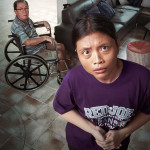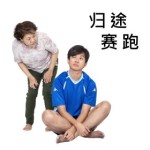“The Silly Little Girl and the Funny Old Tree“
Reviewer: Jocelyn Chng
Performance: 6 April 2019
Loss is a central theme in many of Kuo Pao Kun’s plays from the 1980s and early 1990s – the loss of roots, language, culture, connection; of things that give life a deeper meaning beyond sheer economic progress. In the context of 1980s Singapore, amidst a socio-political environment with an almost singular focus on economic and population growth, Kuo astutely observed that there was a price we were paying as a society.
In The Silly Little Girl and the Funny Old Tree, first performed in 1987, Kuo’s concern about this price is articulated through the relationship between a little girl and a tree, both seen as “misfits” in their own ways by others in their society. The girl is also lonely – we learn that she is a latchkey child who misses her late grandfather and the language and culture that he embodied.
Director Ang Gey Pin has worked intensively on this production with her ensemble cast of child and youth performers from the Young People’s Performing Arts Ensemble (YPPAE), as well as independent adult performers. While some parts of the play have been re-devised and re-worded, it largely respects the spirit of Kuo’s original work.
This is a challenging work to stage due to the non-linearity and sparseness of the script. Both the English and Mandarin versions of the script are only about 15 pages long, there are more monologues than dialogues, and while some stage directions and staging notes are included, much is still left to the creative team and performers to decide how exactly they would like to translate the written script to the stage.
Ang brings to the work her years of experience and practice in physical/movement work¹, which perhaps is both the production’s strength and weakness. The cast performs both coordinated and improvised movement; fast, animated actions as well as slow walks across the stage. For a work so steeped in the language of movement, the demands on the cast are high. Given that the cast comprises a mixture of ages and levels of professionalism, it is unrealistic to expect total precision and focus. However, this also means that while the movement is pleasant to watch, there is too strong an emphasis on this aspect.
This production chooses to highlight the loss of the languages spoken by different Chinese dialect groups in contemporary Singapore. In one particularly moving sequence towards the end, the performers come downstage one after another, sharing monologues that reveal their personal (dis)connections to their dialects. Most performers in their 20s or 30s can speak some dialect, but many also admit a lack of proficiency in it and an accompanying sense of regret. As the series of monologues progresses to the younger cast members, those aged 13 and under not only speak no dialect, but also declare that they do not even know which dialect group their parents belong to. Without lengthy exposition or melodrama, the message comes across loud and clear.
Three decades after its first production, the themes of Silly Little Girl do not feel in any way out of place. Demolition of sites with natural and cultural value to make way for yet another housing development, the linguistic and cultural disconnect that many Chinese Singaporeans have with their dialect heritage… the play could just as well have been written today.
¹Ang is also known for playing the titular role in the original 1987 production of Silly Little Girl; incidentally, that production was co-directed by Taiwanese Grotowski-trained director Liu Jing-min.
Do you have an opinion or comment about this post? Email us at info@centre42.sg.
ABOUT THE PRODUCTION
THE SILLY LITTLE GIRL AND THE FUNNY OLD TREE by Young People’s Performing Arts Ensemble
4 – 6 April 2019
Drama Centre Theatre
ABOUT THE REVIEWER
Jocelyn holds a double Masters in Theatre Studies/Research. She is a founding member of the Song and Dance (SoDa) Players – a registered musical theatre society in Singapore. She is currently building her portfolio career as an educator and practitioner in dance and theatre, while pursuing an MA in Education (Dance Teaching).




